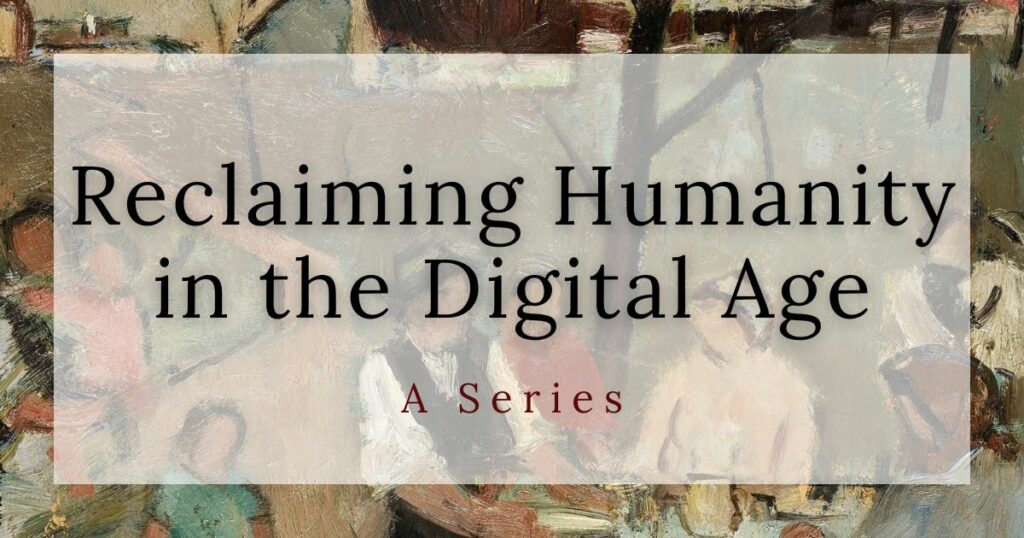This is the fifth installment in a six-part series, “Reclaiming Humanity in the Digital Age.” Check back for more installments soon.
By Joshua Pauling
Part 1 of this series established why it’s necessary to live intentionally in the digital age, Part 2 offered core principles for parenting, Part 3 explored coming of age in the digital world, and Part 4 highlighted how adults should lead the way in forming habits of living that anchor us in our embodied nature as creatures made in God’s image.
Now in Part 5, we turn to the church. What is the role of the church in the digital age, and what theological principles should guide our actions and practices as the church? If there is any institution that has the message, means and methods that can reawaken people to who they are designed to be, it is the church, “built on the foundation of the apostles and prophets, Christ Jesus Himself being the cornerstone” (Eph. 2:20).
‘The Word became flesh’
The opening note of John’s Gospel, “the Word became flesh and dwelt among us” (John 1:14), has massive implications for how we think about the role of technology in the church. Jesus did not come to us as a text message, YouTube video, TikTok reel or social media post. He came to us in human flesh. As theologian Kosuke Koyama provocatively puts it, we have a “three-mile-an-hour God,” a God who moved on earth at the speed of walking. Living in our fast-paced, ever-changing environment, we easily forget that God chose to take on flesh at a time when walking was the most common mode of transport, before electricity or the automobile, before the telephone or television, before the computer or the internet, before the steam engine or the smartphone. God became man; not machine, not message. God became flesh; not image, not video. God united medium and message in Himself. In Christ, God slowed down to our speed, even coming to a “full stop” on the cross, where He took into Himself all the suffering, sin and evil of the whole world. Koyama nails it (pun intended):
Jesus Christ came. He walked towards the “full stop.” He lost his mobility. He was nailed down! … At this point of “full stop,” the apostolic church proclaims that the love of God to man is ultimately and fully revealed. God walks “slowly” because he is love. If he is not love he would have gone much faster. Love has its speed. … It is a different kind of speed from the technological speed to which we are accustomed. It is “slow” yet it is lord over all other speeds since it is the speed of love.[1]
Christ’s incarnational self-giving love is indeed the pattern and paradigm for all the church’s life and work. Below are four key areas where the implications are especially pressing and relevant.
1. In-person worship through Word and Sacrament
Christ’s self-giving most clearly occurs in the context of the church’s worship life, where He has promised to bring life and salvation through the spoken and sacramental Word. Through mundane tangible things like words spoken, water poured and bread and wine received, the corporate Body is swept up together into the great faith-creating mystery of Christ and Him crucified. True Christian worship is fully embodied, profoundly intimate and deeply real. Christ the Bridegroom gives Himself to His bride the church, and the bride receives the life-giving act. Such intimacy and union cannot be fully replicated online, or while alone.[2] Thus, we do not neglect “to meet together” (Heb. 10:25), and we devote ourselves to the same things the early church did: “to the apostles’ teaching and the fellowship, to the breaking of bread and the prayers” (Acts 2:42).
2. Tech-minimal worship
Stepping into the sanctuary should be like stepping into a different world. Digital technologies intrude into every aspect of life already; we don’t need them playing prominent roles in the sanctuary. We would do well to remove superfluous technological layers of mediation, instead fostering the church’s encounter with God through the mediation He has chosen: Word and Sacrament. We can work to reduce (and hopefully eliminate!) the role of screens in worship and consider leaving our smartphones in the car during the Divine Service.[3]
Sacred space and liturgical practice should retain the pristine physicality and simplicity that make Christian worship as relevant and conceivable in the first century as in the 21st century — as low-tech and embodied as possible. Unencumbered by unnecessary cords and cameras. Uninterrupted by flashing screens and notification dings. In such a place, human finitude encounters divine life through water, Word, bread and wine. In such a place, one is steered away from digital evanescence and restored into the realm of the real, both transcendent and physical. Amid liturgical practices that are embodied, authentic, communal, frequent and ritualized, the habits and patterns of the digital age are disrupted, subverted and overcome by the God-man who gives His redemptive and restorative gifts to man.
3. The tangible book
Christians have been known historically as people of the Book. While there is a place for accessing Scripture through screen-based devices, we should not forget the importance of using physical Bibles, hymnals and prayer books, especially for gathered worship, Sunday school and home devotions. This is not for the sake of nostalgia, but because the use of a physical book has an inherent message: It makes a clear distinction between the ever-changing words read on the screen, and the timeless, objectively true words of Scripture. Physical texts communicate a message beyond the one contained in their pages, while digital versions send a different message that easily obscures Christianity’s core incarnational reality. Consider the irony of reading about how “the Word of the Lord endures forever” on a screen where the words vanish into the ether of digital space with a click or swipe. The brain also interacts with physical texts more naturally than digital texts, because a physical book has a landscape by which the brain creates a mental map of the content that greatly aids in understanding, retention and memorization.[4]
4. Embodied community and robust church membership
Lastly, in an age of shallow, thin connections, the church offers authentic, thick community. The digital environment offers countless voices and competing authorities that vie for our attention. The experience of consuming so much content can cause us to view the church through a consumeristic lens as just another streaming service or content provider. But becoming a member of a local church fights against these tendencies. You are no longer just choosing from endless preachers, life coaches, podcasts or content online; you are submitting to the authority of the Word and to the pastoral care and oversight of a local body.
The church is a locally embedded but universally embodied communion united to Christ. This means the church plays an entirely different role than online communities or content providers. In the local church, the embodied riches and mysteries of the Gospel anchor us to a place and a people, as our lives are together and forever marked by Christ and His gifts. As more of life is absorbed into the machine and digital content proliferates, opportunities for real, in-person life together are becoming ever rarer and more precious. As AI and deepfake technologies become widespread, the most reliable source of truth will more than ever be in-person, real-time gatherings, something the church has been doing for thousands of years. Further, embracing the embodied community of the local church can help us resist the consumeristic mindset that places the individual with their ideas and preferences above the Word of God and the church’s authority. We must remember that the church is not a gathering of autonomous individuals exercising their tastes in what church they choose or what pastor they prefer. The church is a body. St. Paul chooses this profoundly intimate and interconnected image because it is what the church truly is: Christ’s Body. It is in Christ’s Body that we can know and be known; can give and receive; and can find true intimacy, authenticity, belonging and identity.
Conclusion
To be clear, all the above is not to deny any role for digital technologies in the life of the church. Rather, it is an attempt to put such things in their proper place. Digital technologies cannot become substitutes for Word and Sacrament ministry and the embodied life together of the local congregation. Perhaps it is better to think of a church’s online presence and use of digital technologies more like the church foyer, or gateway into the church, rather than the church itself. We should do our best to present a polished and compelling representation of our doctrine and practice online to help people make their way into the sanctuary. For that is where Christ gives His gifts.
If there is any institution, belief system — or better yet, Person — designed to withstand the onslaught of the digital age, it is the church, Christian doctrine and Christ Himself — the True Human. The church is primed and prepared for the personal communication of truth, is well-practiced at gathering in person, doing life together, and presenting information orally through proclamation and teaching. The church is an embodied communion, gathered to hear the Word, to receive Christ bodily in the Eucharist and to share in life together with other members of Christ’s Body. The church knows how to do this and provides the belief structures and bodily practices to flourish in the digital age. The church brings us into the Divine Life, a life where humanity is fully forgiven and fully alive, united to Jesus, the ever-incarnate One, who still has His body — a glorious, wounded body with holes in His hands, and in His feet, and in His side. And there is nothing digital about that.
[1] Kosuke Koyama, Three Mile an Hour God, (London: SCM Press, 2021), 7–8.
[2] For a more thorough treatment of the question of online/streaming worship, see chapter 14 of Phillips and Pauling, Are We All Cyborgs Now? I’ve also addressed this issue in: LOGIA, “Livestreaming Ourselves to Death”; The Public Discourse, “After Zoom Church”; Modern Reformation, “Going Upstream of Streaming Worship.”
[3] While this may seem like an impossible task and the practicalities would be challenging, I’d love to see if there is way to work towards our sanctuaries being phone free — not by rule or fiat, but through slow and gentle catechesis encouraging one another along the path, and by individuals choosing to leave their devices at home, in the car, or somewhere else. This is not as crazy as you may think. Brad East argues for this in a recent article entitled “A Vision for Screen-Free Church,” Christianity Today, Oct. 28, 2024, christianitytoday.com/2024/10/a-vision-for-screen-free-church-smartphones-livestreaming. He asks: “How, after all, can we disciples be wise and patient and alert and unanxious women and men of prayer, who dwell in the word of God, who know how to be still, who listen for the voice of Christ’s Spirit — how can we be any of these things if every second of our lives is fixated on our screens, eyes scrolling indefinitely and infinitely for the latest image, the latest scandal, the latest outrage? How can we be different from anybody else if here, in the midst of God’s people, on the Lord’s Day, gathered to worship in the Spirit, we can’t let go of our digital addictions for even one hour?”
[4] For more on this, see chapter 29 of Phillips and Pauling, Are We All Cyborgs Now? and Ferris Jabr, “The Reading Brain in the Digital Age: The Science of Paper Versus Screens,” Scientific American, April 11, 2013, scientificamerican.com/article/reading-paper-screens.






I would love to keep my cell phone at home but you see, I need it for my hearing aids. They are located ON the cell phone. I need to turn them on – on the cell phone. I need to turn my t-coil on so the audio-loop system in the church is in sync with my hearing aids. This way I can hear what the preacher is saying in the microphone during the service. Otherwise….I am deaf/hard of hearing. Then I might as well stay home. LCMS does not address this issue. I am NOT totally DEAF – I do not use ASL – sign language. THEN, I would stay home for sure. Most of our congregation uses the LOOP system in our church so they can hear well. You all ought to encourage other churches to do the same.
In my experience, one delightful benefit that can come from using screens in the sanctuary is that with heads up and eyes front, we hear each other better. Consequently, the stronger auditory connection increases my sense that we are worshipping as a community and not simply attending a service at the same time. Especially when we sing, when I hear across several rows of pews individual voices that are variously young and old, weak and strong, treble and bass, there comes a joy that can bring a smile to my face and further motivate me to “make a joyful noise” with my brothers and sisters.